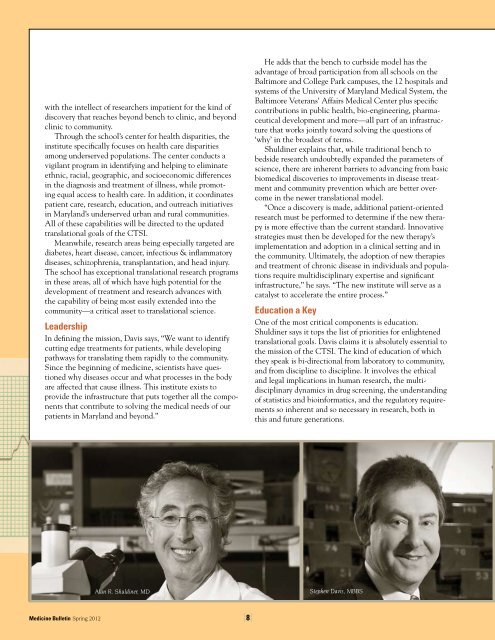Medical Alumni Association of the University of Maryland
Medical Alumni Association of the University of Maryland
Medical Alumni Association of the University of Maryland
Create successful ePaper yourself
Turn your PDF publications into a flip-book with our unique Google optimized e-Paper software.
with <strong>the</strong> intellect <strong>of</strong> researchers impatient for <strong>the</strong> kind <strong>of</strong><br />
discovery that reaches beyond bench to clinic, and beyond<br />
clinic to community.<br />
Through <strong>the</strong> school’s center for health disparities, <strong>the</strong><br />
institute specifically focuses on health care disparities<br />
among underserved populations. The center conducts a<br />
vigilant program in identifying and helping to eliminate<br />
ethnic, racial, geographic, and socioeconomic differences<br />
in <strong>the</strong> diagnosis and treatment <strong>of</strong> illness, while promoting<br />
equal access to health care. In addition, it coordinates<br />
patient care, research, education, and outreach initiatives<br />
in <strong>Maryland</strong>’s underserved urban and rural communities.<br />
All <strong>of</strong> <strong>the</strong>se capabilities will be directed to <strong>the</strong> updated<br />
translational goals <strong>of</strong> <strong>the</strong> CTSI.<br />
Meanwhile, research areas being especially targeted are<br />
diabetes, heart disease, cancer, infectious & inflammatory<br />
diseases, schizophrenia, transplantation, and head injury.<br />
The school has exceptional translational research programs<br />
in <strong>the</strong>se areas, all <strong>of</strong> which have high potential for <strong>the</strong><br />
development <strong>of</strong> treatment and research advances with<br />
<strong>the</strong> capability <strong>of</strong> being most easily extended into <strong>the</strong><br />
community—a critical asset to translational science.<br />
Leadership<br />
In defining <strong>the</strong> mission, Davis says, “We want to identify<br />
cutting edge treatments for patients, while developing<br />
pathways for translating <strong>the</strong>m rapidly to <strong>the</strong> community.<br />
Since <strong>the</strong> beginning <strong>of</strong> medicine, scientists have questioned<br />
why diseases occur and what processes in <strong>the</strong> body<br />
are affected that cause illness. This institute exists to<br />
provide <strong>the</strong> infrastructure that puts toge<strong>the</strong>r all <strong>the</strong> components<br />
that contribute to solving <strong>the</strong> medical needs <strong>of</strong> our<br />
patients in <strong>Maryland</strong> and beyond.”<br />
Medicine Bulletin Spring 2012 [8]<br />
He adds that <strong>the</strong> bench to curbside model has <strong>the</strong><br />
advantage <strong>of</strong> broad participation from all schools on <strong>the</strong><br />
Baltimore and College Park campuses, <strong>the</strong> 12 hospitals and<br />
systems <strong>of</strong> <strong>the</strong> <strong>University</strong> <strong>of</strong> <strong>Maryland</strong> <strong>Medical</strong> System, <strong>the</strong><br />
Baltimore veterans’ Affairs <strong>Medical</strong> Center plus specific<br />
contributions in public health, bio-engineering, pharmaceutical<br />
development and more—all part <strong>of</strong> an infrastructure<br />
that works jointly toward solving <strong>the</strong> questions <strong>of</strong><br />
‘why’ in <strong>the</strong> broadest <strong>of</strong> terms.<br />
Shuldiner explains that, while traditional bench to<br />
bedside research undoubtedly expanded <strong>the</strong> parameters <strong>of</strong><br />
science, <strong>the</strong>re are inherent barriers to advancing from basic<br />
biomedical discoveries to improvements in disease treatment<br />
and community prevention which are better overcome<br />
in <strong>the</strong> newer translational model.<br />
“Once a discovery is made, additional patient-oriented<br />
research must be performed to determine if <strong>the</strong> new <strong>the</strong>rapy<br />
is more effective than <strong>the</strong> current standard. Innovative<br />
strategies must <strong>the</strong>n be developed for <strong>the</strong> new <strong>the</strong>rapy’s<br />
implementation and adoption in a clinical setting and in<br />
<strong>the</strong> community. Ultimately, <strong>the</strong> adoption <strong>of</strong> new <strong>the</strong>rapies<br />
and treatment <strong>of</strong> chronic disease in individuals and populations<br />
require multidisciplinary expertise and significant<br />
infrastructure,” he says. “The new institute will serve as a<br />
catalyst to accelerate <strong>the</strong> entire process.”<br />
Education a Key<br />
One <strong>of</strong> <strong>the</strong> most critical components is education.<br />
Shuldiner says it tops <strong>the</strong> list <strong>of</strong> priorities for enlightened<br />
translational goals. Davis claims it is absolutely essential to<br />
<strong>the</strong> mission <strong>of</strong> <strong>the</strong> CTSI. The kind <strong>of</strong> education <strong>of</strong> which<br />
<strong>the</strong>y speak is bi-directional from laboratory to community,<br />
and from discipline to discipline. It involves <strong>the</strong> ethical<br />
and legal implications in human research, <strong>the</strong> multidisciplinary<br />
dynamics in drug screening, <strong>the</strong> understanding<br />
<strong>of</strong> statistics and bioinformatics, and <strong>the</strong> regulatory requirements<br />
so inherent and so necessary in research, both in<br />
this and future generations.<br />
Alan R. Shuldiner, MD Stephen Davis, MBBS



